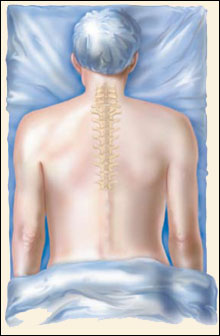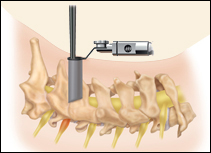Minimally Invasive Posterior Cervical Foraminotomy
ALIF - Anterior Lumbar Interbody Fusion :: TLIF - Transforaminal Lumbar Interbody Fusion
Balloon Kyphoplasty :: PLIF - Posterior Lumbar Interbody Fusion Surgery
Pars Fracturs/Defects :: Lumbar Microdiscectomy
Cervical foraminotomy is a surgical procedure done to relieve the symptoms of a pinched nerve by enlarging the neural foramen, and it can be performed in a minimally invasive way.
The neural foramen is an opening where nerve roots exit the spine and travel throughout the body. It creates a protective passageway for nerves that carry signals between the spinal cord and the rest of the body. A cervical foraminotomy is a surgical procedure that is done to enlarge that passageway.
Traditional, open spine surgery involves cutting or stripping the muscles from the spine. Today, a cervical foraminotomy may be performed using a minimally invasive procedure that allows your spine surgeon to separate the fibers of the muscles surrounding the spine rather than cutting and stripping the muscles away from the spine.
 Why is it done? Why is it done?
A pinched nerve in the neck can cause neck pain, stiffness, and pain radiating into the shoulder, arm, and hand, as well as numbness, tingling and/or weakness in the arm and hand.
Herniated discs, bone spurs and thickened ligaments or joints can all cause narrowing of the neural foramen and cause painful symptoms. Patients who do not improve with conservative treatment may be candidates for surgery.
How is it done?
The Operation
The operation is performed with the patient on his or her stomach.
Decompression
A small incision is made on the symptomatic side of the neck. Next, the muscles are gradually dilated and a tubular retractor is placed to give the surgeon access to the spine.
Bone or disc material and/or thickened ligaments are then removed to decompress and relieve  pressure on the spinal cord and/or nerves. pressure on the spinal cord and/or nerves.
The tubular retractor is removed, allowing the dilated muscles to come back together.
Closure
The incision is closed, and in most instances results in only a small scar.
After Surgery
This minimally invasive procedure typically allows many patients to be discharged the same day of surgery; however, some patients will require a longer hospital stay. Most patients will notice immediate improvement of some or all of their symptoms; however, other symptoms may improve more gradually.
A positive attitude, reasonable expectations and compliance with your doctor's post-surgery instructions all may contribute to a satisfactory outcome. Many patients are able to return to their regular activities within several weeks.
It is important that you discuss the potential risks, complications, and benefits of spinal surgery with your doctor prior to receiving treatment, and that you rely on your physician's judgment. Only your doctor can determine whether you are a suitable candidate for this treatment.
The materials on this Web site are for your general educational information only. Information you read on this Web site cannot replace the relationship that you have with your health care professional. We do not practice medicine or provide medical services or advice as a part of this Web site. You should always talk to your health care professional for diagnosis and treatment.
|


